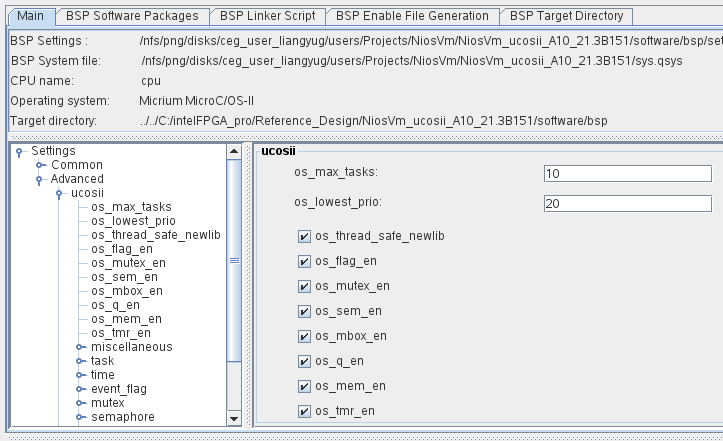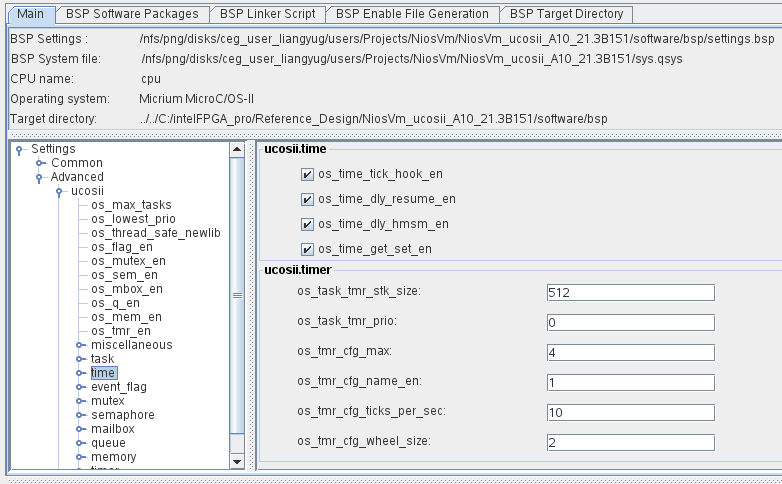A newer version of this document is available. Customers should click here to go to the newest version.
1. Overview of Nios® V Embedded Processor Development
2. Getting Started from the Command Line
3. Nios® V Processor Software Development and Implementation
4. Nios® V Processor Board Support Package Editor
5. Overview of the Hardware Abstraction Layer
6. Developing Programs Using the Hardware Abstraction Layer
7. Developing Device Drivers for the Hardware Abstraction Layer
8. Exception Handling
9. Cache and Tightly-Coupled Memory
10. MicroC/OS-II Real-Time Operating System
11. MicroC/TCP-IP Protocol Stack
12. FreeRTOS* Real-Time Operating System
13. Read-Only Zip File System
14. Publishing Component Information to Embedded Software
15. Nios® V Processor Appendix
A. Nios® V Processor Software Developer Handbook Archives
16. Revision History for the Nios® V Processor Software Developer Handbook
3.3.2.1. Selecting the Operating System
3.3.2.2. Intel HAL Configuration Tips
3.3.2.3. Micrium MicroC/OS-II Configuration tips
Configuring MicroC/OS-II timer Device using Tcl Script
3.3.2.4. Configuring FreeRTOS*
3.3.2.5. Adding Software Package
3.3.2.6. Using Tcl Script with BSP Editor
3.3.2.7. Exporting Tcl Scripts with BSP Editor
3.3.2.8. Importing Tcl Script to Create a New BSP
6.1. HAL BSP Settings
6.2. The Nios® V Processor Embedded Project Structure
6.3. The system.h System Description File
6.4. Data Widths and the HAL Type Definitions
6.5. UNIX-Style Interface
6.6. Using Character-Mode Devices
6.7. Using Timer Devices
6.8. Using Flash Devices
6.9. Using DMA Devices
6.10. Interrupt Controllers
6.11. Reducing Code Footprint in Embedded Systems
6.12. Boot Sequence and Entry Point
6.13. Memory Usage
6.14. Working with HAL Source Files
6.11.1. Apply Compiler Flags
6.11.2. Use Small Variant Device Drivers
6.11.3. Reduce the File Descriptor Pool
6.11.4. Use /dev/null
6.11.5. Use a Smaller File I/O Library
6.11.6. Use the Minimal Character-Mode API
6.11.7. Eliminate Unused Device Drivers
6.11.8. Use the Picolibc Library
6.11.9. Eliminate Unused alt_load()
6.11.10. Eliminate Unneeded Exit Code
7.1. Driver Integration in the HAL API
7.2. The HAL Peripheral-Specific API
7.3. Preparing for HAL Driver Development
7.4. Development Flow for Creating Device Drivers
7.5. Nios® V Processor Hardware Design Concepts
7.6. Accessing Hardware
7.7. Creating Embedded Drivers for HAL Device Classes
7.8. Integrating a Device Driver in the HAL
7.9. Creating a Custom Device Driver for the HAL
7.10. Reducing Code Footprint in HAL Embedded Drivers
7.11. HAL Namespace Allocation
7.12. Overriding the HAL Default Device Drivers
7.8.5.2.1. Creating and Naming the Driver or Package
7.8.5.2.2. Identifying the Hardware Component Class
7.8.5.2.3. Setting the BSP Type
7.8.5.2.4. Specifying an Operating System
7.8.5.2.5. Specifying Source Files
7.8.5.2.6. Specifying a Subdirectory
7.8.5.2.7. Enabling Software Initialization
7.8.5.2.8. Adding Include Paths
7.8.5.2.9. Version Compatibility
8.1. Nios® V Processor Exception Handling Overview
8.2. Nios® V Processor Hardware Interrupt Service Routines
8.3. Nios® V Processor Software Interrupt Service Routines
8.4. Improving Nios® V Processor ISR Performance
8.5. Debugging Nios® V Processor ISRs
8.6. HAL Exception Handling System Implementation
8.7. Nios® V Processor Instruction-Related Exception Handler
8.4.1.1. Execute Time-Intensive Algorithms in the Application Context
8.4.1.2. Implement Time-Intensive Algorithms in Hardware
8.4.1.3. Increase Buffer Size
8.4.1.4. Use Double Buffering
8.4.1.5. Keep Interrupts Enabled
8.4.1.6. Use Fast Memory
8.4.1.7. Use a Separate Exception Stack
8.4.1.8. Use Nested Hardware Interrupts
8.4.1.9. Use Compiler Optimization
11.1. Overview of the MicroC/TCP-IP Protocol Stack
11.2. Support and Licensing
11.3. Prerequisites for Understanding the MicroC/TCP-IP Protocol Stack
11.4. Introduction to the MicroC/TCP-IP Protocol Stack - Nios® V Processor Edition
11.5. The MicroC/TCP-IP Protocol Stack Files and Directories
11.6. Enabling MicroC/TCP-IP Protocol Stack
11.7. Using the MicroC/TCP-IP Protocol Stack
15.1.1.1. _exit()
15.1.1.2. _rename()
15.1.1.3. alt_dcache_flush()
15.1.1.4. alt_dcache_flush_all()
15.1.1.5. alt_icache_flush_all()
15.1.1.6. alt_dcache_flush_no_writeback()
15.1.1.7. alt_icache_flush_all()
15.1.1.8. alt_icache_flush()
15.1.1.9. alt_alarm_start()
15.1.1.10. alt_alarm_stop()
15.1.1.11. alt_dma_rxchan_depth()
15.1.1.12. alt_dma_rxchan_close()
15.1.1.13. alt_dev_reg()
15.1.1.14. alt_dma_rxchan_open()
15.1.1.15. alt_dma_rxchan_prepare()
15.1.1.16. alt_dma_rxchan_reg()
15.1.1.17. alt_dma_txchan_close()
15.1.1.18. alt_dma_txchan_ioctl()
15.1.1.19. alt_dma_txchan_open()
15.1.1.20. alt_dma_txchan_reg()
15.1.1.21. alt_flash_close_dev()
15.1.1.22. alt_exception_cause_generated_bad_addr()
15.1.1.23. alt_erase_flash_block()
15.1.1.24. alt_dma_rxchan_ioctl()
15.1.1.25. alt_dma_txchan_space()
15.1.1.26. alt_dma_txchan_send()
15.1.1.27. alt_flash_open_dev()
15.1.1.28. alt_fs_reg()
15.1.1.29. alt_get_flash_info()
15.1.1.30. alt_ic_irq_disable()
15.1.1.31. alt_ic_irq_enabled()
15.1.1.32. alt_ic_isr_register()
15.1.1.33. alt_ic_irq_enable()
15.1.1.34. alt_instruction_exception_register()
15.1.1.35. alt_irq_cpu_enable_interrupts ()
15.1.1.36. alt_irq_disable_all()
15.1.1.37. alt_irq_enable_all()
15.1.1.38. alt_irq_enabled()
15.1.1.39. alt_irq_init()
15.1.1.40. alt_irq_pending ()
15.1.1.41. alt_llist_insert()
15.1.1.42. alt_llist_remove()
15.1.1.43. alt_load_section()
15.1.1.44. alt_nticks()
15.1.1.45. alt_read_flash()
15.1.1.46. alt_tick()
15.1.1.47. alt_ticks_per_second()
15.1.1.48. alt_timestamp()
15.1.1.49. alt_timestamp_freq()
15.1.1.50. alt_timestamp_start()
15.1.1.51. alt_write_flash()
15.1.1.52. alt_write_flash_block()
15.1.1.53. close()
15.1.1.54. fstat()
15.1.1.55. fork()
15.1.1.56. fcntl()
15.1.1.57. execve()
15.1.1.58. getpid()
15.1.1.59. kill()
15.1.1.60. stat()
15.1.1.61. settimeofday()
15.1.1.62. wait()
15.1.1.63. unlink()
15.1.1.64. sbrk()
15.1.1.65. link()
15.1.1.66. lseek()
15.1.1.67. open()
15.1.1.68. alt_sysclk_init()
15.1.1.69. times()
15.1.1.70. read()
15.1.1.71. write()
15.1.1.72. usleep()
15.1.1.73. alt_lock_flash()
15.1.1.74. gettimeofday()
15.1.1.75. ioctl()
15.1.1.76. isatty()
15.1.1.77. alt_niosv_enable_msw_interrupt()
15.1.1.78. alt_niosv_disable_msw_interrupt()
15.1.1.79. alt_niosv_is_msw_interrupt_enabled()
15.1.1.80. alt_niosv_trigger_msw_interrupt()
15.1.1.81. alt_niosv_clear_msw_interrupt()
15.1.1.82. alt_niosv_register_msw_interrupt_handler()
15.5.2.1. add_memory_device
15.5.2.2. add_memory_region
15.5.2.3. add_section_mapping
15.5.2.4. are_same_resource
15.5.2.5. delete_memory_region
15.5.2.6. delete_section_mapping
15.5.2.7. disable_sw_package
15.5.2.8. enable_sw_package
15.5.2.9. get_addr_span
15.5.2.10. get_assignment
15.5.2.11. get_available_drivers
15.5.2.12. get_available_sw_packages
15.5.2.13. get_base_addr
15.5.2.14. get_break_offset
15.5.2.15. get_break_slave_desc
15.5.2.16. get_cpu_name
15.5.2.17. get_current_memory_regions
15.5.2.18. get_current_section_mappings
15.5.2.19. get_default_memory_regions
15.5.2.20. get_driver
15.5.2.21. get_enabled_sw_packages
15.5.2.22. get_exception_offset
15.5.2.23. get_exception_slave_desc
15.5.2.24. get_fast_tlb_miss_exception_offset
15.5.2.25. get_fast_tlb_miss_exception_slave_desc
15.5.2.26. get_interrupt_controller_id
15.5.2.27. get_irq_interrupt_controller_id
15.5.2.28. get_irq_number
15.5.2.29. get_memory_region
15.5.2.30. get_module_class_name
15.5.2.31. get_module_name
15.5.2.32. get_reset_offset
15.5.2.33. get_reset_slave_desc
15.5.2.34. get_section_mapping
15.5.2.35. get_setting
15.5.2.36. get_setting_desc
15.5.2.37. get_slave_descs
15.5.2.38. is_char_device
15.5.2.39. is_connected_interrupt_controller_device
15.5.2.40. is_connected_to_data_master
15.5.2.41. is_connected_to_instruction_master
15.5.2.42. is_ethernet_mac_device
15.5.2.43. is_flash
15.5.2.44. is_memory_device
15.5.2.45. is_non_volatile_storage
15.5.2.46. is_timer_device
15.5.2.47. log_debug
15.5.2.48. log_default
15.5.2.49. log_error
15.5.2.50. log_verbose
15.5.2.51. set_driver
15.5.2.52. set_ignore_file
15.5.2.53. set_setting
15.5.2.54. update_memory_region
15.5.2.55. update_section_mapping
15.5.2.56. add_default_memory_regions
15.5.2.57. create_bsp
15.5.2.58. generate_bsp
15.5.2.59. get_available_bsp_type_versions
15.5.2.60. get_available_bsp_types
15.5.2.61. get_available_cpu_architectures
15.5.2.62. get_available_cpu_names
15.5.2.63. get_available_software
15.5.2.64. get_available_software_setting_properties
15.5.2.65. get_available_software_settings
15.5.2.66. get_bsp_version
15.5.2.67. get_cpu_architecture
15.5.2.68. get_sopcinfo_file
15.5.2.69. get_supported_bsp_types
15.5.2.70. is_bsp_hal_extension
15.5.2.71. open_bsp
15.5.2.72. save_bsp
15.5.2.73. set_bsp_version
15.5.2.74. set_logging_mode
15.5.3.1. add_class_sw_setting
15.5.3.2. add_class_systemh_line
15.5.3.3. add_module_sw_property
15.5.3.4. add_module_sw_setting
15.5.3.5. add_module_systemh_line
15.5.3.6. add_systemh_line
15.5.3.7. get_class_peripheral
15.5.3.8. get_module_assignment
15.5.3.9. get_module_name
15.5.3.10. get_module_peripheral
15.5.3.11. get_module_sw_setting_value
15.5.3.12. get_peripheral_property
15.5.3.13. remove_class_systemh_line
15.5.3.14. remove_module_systemh_line
15.5.3.15. set_class_sw_setting_property
15.5.3.16. set_module_sw_setting_property
3.3.2.3. Micrium MicroC/OS-II Configuration tips
If you use the MicroC/OS-II environment, be aware of the following properties:
- MicroC/OS-II BSP settings: The MicroC/OS-II supports many configuration options. All these options can be enabled and disabled with BSP settings.
- MicroC/OS-II setting modification: Modifying the MicroC/OS-II options modify the system.h file, which is used to compile the BSP library file.
- MicroC/OS-II initialization: The core MicroC/OS-II is initialized during the execution of the C run-time initialization (crt0) code block. After the crt0 code block runs, the MicroC/OS-II RTOS resources are available for your application to use.
You can configure MicroC/OS-II with the BSP Editor. Figure Enabling MicroC/OS-II Timers and Queues in BSP Editor shows how you enable the MicroC/OS-II timer and queue code. Figure Configuring MicroC/OS-II for Four Timers in BSP Editor shows how you specify a maximum of four timers for use with MicroC/OS-II. The MicroC/OS-II Tcl script below performs the same MicroC/OS-II in these two figures.
Figure 2. Enabling MicroC/OS-II Timers and Queues in BSP Editor


Figure 3. Configuring MicroC/OS-II for Four Timers in BSP Editor


Configuring MicroC/OS-II timer Device using Tcl Script
#enable code for UCOSII timers set_setting ucosii.os_tmr_en 1 #enable code for UCOSII queues set_setting ucosii.os_q_en 1 #enable a maximum of 4 UCOSII timers set_setting ucosii.timer.os_tmr_cfg_max 4
Related Information